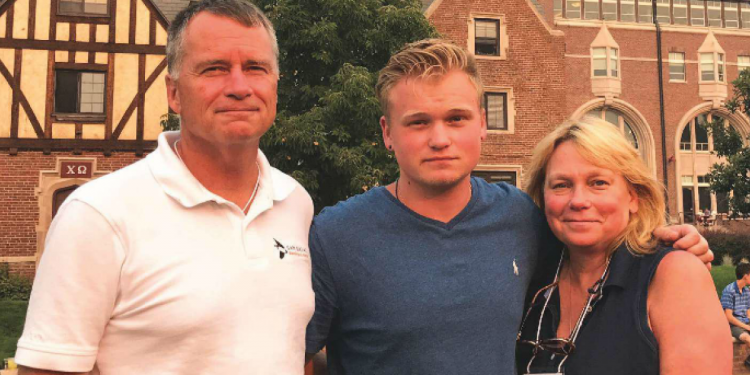The Opioid Epidemic by the Numbers:
- 21 to 29 percent of people who are prescribed opioids for chronic pain misuse them.
- 4 to 6 percent of people who misuse prescription opioids later use heroin.
- The opioid epidemic costs the U.S. approximately $80 billion per year.
- In 2017, the Center for Disease Control and Prevention lowered Americans’ life expectancy to 78.5 years because of opioid-related deaths.
- Between 2002 and 2017, the number of deaths from opioid overdoses quadrupled.
This is one military family’s story of loss. Hope. And change.
In September 2017, Jonathan Winnefeld entered his freshman year at the University of Denver. Having just completed 15 months of treatment for a dual diagnosis of depression/anxiety and addiction, he felt inspired to help others. But Jonathan told a friend that he had been offered heroin just weeks before classes began.
He’d refused it.
His parents believe this triggered a relapse which led him to purchase a fatal fentanyl-laced dose of heroin. Three days after school began, Jonathan was found unresponsive in his dorm room, becoming one of almost 50,000 people who died from an opioid overdose that year.
Jonathan’s story doesn’t begin in poverty or any other stereotypical backdrop of a drug scene. It begins within the military community. That’s what his parents, Retired Adm. James “Sandy” Winnefeld, former Vice Chairman of the Joint Chiefs of Staff, and his wife Mary, want you to know: the opioid epidemic doesn’t discriminate. In November 2017, the Winnefelds founded the nonprofit, Stop the Addiction Fatality Epidemic (SAFE), to combat the opioid epidemic and support families who are affected by it.
A Devastating Illness
Jonathan was athletic, friendly and compassionate. He was introverted, but his buddies remember him as the friend who stood up for them. Having once moved six times in three years, he knew the challenges of military life.
As a young teen, Jonathan was misdiagnosed with attention deficit disorder and prescribed Adderall. To calm himself, he drank alcohol. He later used marijuana and Xanax, and ultimately became addicted to heroin. Studies show that opioids physically and chemically alter the brain, reshaping its neural pathways and changing the way a person processes information, emotion and desire.
A young person’s developing brain is even more susceptible.
Jonathan’s parents paid the equivalent of four years of private college tuition for treatment because TRICARE didn’t cover the costs to treat Jonathan’s dual diagnosis. Recovery often requires more than detoxification and group therapy.
“Addiction is an illness,” says Rosemary Williams, SAFE’s executive director. “It’s not something you can just turn your back on.”
Jonathan emerged from recovery with a desire to live, but he didn’t have sufficient support to sustain his reentry into society. Recognizing the complexities of the disease and recovery, SAFE developed an integrated approach to prevent the epidemic and create support for those affected by addiction. Their ultimate goal is to establish SAFE communities and SAFE campuses around the country.
A Necessary Education
Understanding the potential exposure to opioids within your own family begins with taking a hard look at what is already in your home. “I don’t think there is a military family anywhere that does not have opioids in their medicine cabinet,” Rosemary reflects. Many service members are prescribed opioids to manage pain resulting from the physical demands of their jobs. Military spouses and kids are prescribed opioids, too, following procedures like caesarean sections or wisdom teeth removal.
“A lot of people don’t even know what opioids are,” Mary says.
SAFE provides a helpful fact sheet that can help you get acquainted with the many generic forms of opioid medications. It also suggests possible alternative medications. Common opioids include hydrocodone (Vicodin), oxycodone (OxyContin, Percocet), oxymorphone (Opana), morphine (Kadian, Avinza), codeine, and fentanyl.
Next, dispose of opioids and other medications safely. Never flush opioids down the toilet. Every military treatment facility has a take-back program available to beneficiaries, which helps prevent the misuse of medications later.
Finally, reach out for help if you sense that someone you love is in need. Sudden changes in behavior are an indication that something is wrong and that is the time to offer help, Mary says. Doing things to excess, including eating, sleeping and even exercising, can also indicate that “someone’s life-balance is off.” Some might hesitate accessing help because they fear that the stigma could harm their service member’s career. But Mary reminds military spouses that the greater disservice would be to refrain from getting well. Military spouses’ health and wellness affects the entire family, including the service member. “We need to keep the families healthy,” she says.
The Winnefelds share Jonathan’s story with young people across the country. They also encourage parents to use age-appropriate measures to help kids understand the dangers of Opioids and substance abuse.
Keep these 3 tips in mind:
- Don’t Lecture: Share stories that kids can relate to.
- Arm Kids With Knowledge: Explain the science behind drugs’ effect on the brain.
- Put things into perspective: Asking for help can feel uncomfortable, even if it’s for a friend. Ask kids which feels worse: feeling uncomfortable now or losing someone they love a year from now?
A Way Forward
“Life never goes as planned,” Mary says, reflecting on Jonathan’s loss. Knowing she is making a difference motivates her to move forward. “We really want to be an organization that gets something done. What we tell our staff is that every day, when you wake up in the morning, think, ‘Let’s save a life today.’ And then, at the end of the day, say, ‘Did we save a life today?’ You can join SAFE’s efforts by volunteering or by forming a SAFE community in your area. Find more information at safeproject.us.








